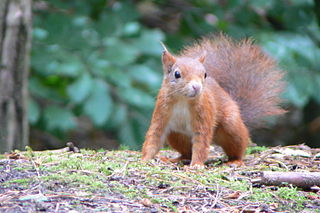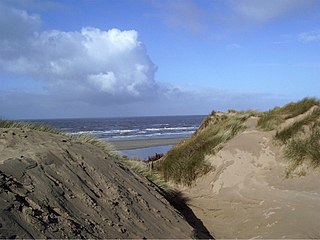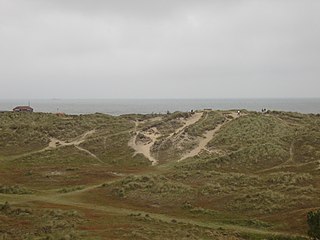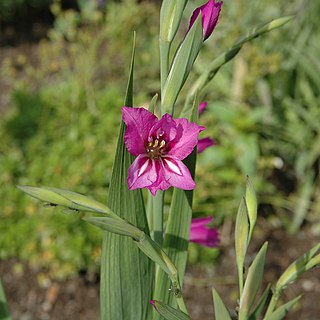| Site of Special Scientific Interest | |
 | |
| Area of Search | Merseyside |
|---|---|
| Grid reference | SD295106 |
| Coordinates | 53°35′06″N3°03′40″W / 53.585°N 3.061°W Coordinates: 53°35′06″N3°03′40″W / 53.585°N 3.061°W |
| Interest | Biological and Geological |
| Area | 4605.32 hectares, 11,380 acres (46,100,000 m2) |
| Notification | 16 August 2000 |
| Natural England website | |
Sefton Coast is a 4605.3 hectare (11379.9 acre) Site of special scientific interest which stretches for 12 miles (20 km) between Southport and Waterloo, which is end location of Crosby Beach. The site was notified in 2000 for both its biological and geological features. The coast has species such as grass of Parnassus, wild orchids, rare butterflies, sand lizards, natterjack toads and waders. [1]

Southport is a large seaside town in Merseyside, England. At the 2001 census, it had a population of 90,336, making it the eleventh most populous settlement in North West England.

Waterloo is an area of the Metropolitan Borough of Sefton, in Merseyside, England. Along with Seaforth the two localities make up the Sefton Ward of Church. The area is bordered by Crosby to the north, Seaforth to the south, the Rimrose Valley country park to the east, and to the west the Crosby Beach and Crosby Coastal Park.

Crosby Beach is part of the Merseyside coastline north of Liverpool in the Metropolitan Borough of Sefton, England, stretching about 2.5 miles (4.0 km) North-West from the Seaforth Dock in the Port of Liverpool, through Waterloo, where it separates the sea from the Marina. The beach has been the permanent home of the Another Place sculptures by Antony Gormley since 2007.
Sefton Coast includes Crosby beach which is also the site of an art installation by Antony Gormley, called Another Place. Further north is the National Trust site of Formby Point containing pinewoods and sand dunes. [2] The whole of the coastline here is managed as a Special Area of Conservation(SAC) [3] for its important wildlife reserves by Sefton Coast Partnership. The pine woods at Victoria Road have been established as a National Trust reserve for the red squirrel, listed on the endangered species list. Formby is one of several sites in Britain where the red squirrel can still be found although it is now being threatened by the grey squirrel. [4]

Sir Antony Mark David Gormley,, is a British sculptor. His best known works include the Angel of the North, a public sculpture in Gateshead in the North of England, commissioned in 1994 and erected in February 1998, Another Place on Crosby Beach near Liverpool, and Event Horizon, a multi-part site installation which premiered in London in 2007, around Madison Square in New York City, in 2010, in São Paulo, Brazil, in 2012, and in Hong Kong in 2015–16.

Another Place is a piece of modern sculpture by Sir Antony Gormley located at Crosby Beach in Merseyside, England. It consists of 100 cast iron figures facing towards the sea. The figures are modelled on the artist's own naked body. The work proved controversial due to the naked statues but has increased tourism to the beach. After being exhibited at two other locations in space meeting by Sefton Metropolitan Borough Council on 7 March 2007 decided that the sculptures should be permanently installed at the beach.
A Special Area of Conservation (SAC) is defined in the European Union's Habitats Directive (92/43/EEC), also known as the Directive on the Conservation of Natural Habitats and of Wild Fauna and Flora. They are to protect the 220 habitats and approximately 1000 species listed in annex I and II of the directive which are considered to be of European interest following criteria given in the directive. They must be chosen from the Sites of Community Importance by the State Members and designated SAC by an act assuring the conservation measures of the natural habitat.
The coast is also famous for the presence of Natterjack toads in Formby. Formby is only one of a few sites in England where they will breed. Later in the evening the male's distinctive song can be heard and is known locally as the 'Bootle Organ'. In spring the males gather at the edge of shallow pools in the dune slacks and sing to attract a mate. The Sefton Coast and Countryside Service are working hard to keep these pools from growing over so that they are ready each spring for this annual event. [5]

The natterjack toad is a toad native to sandy and heathland areas of Europe. Adults are 60–70 mm in length and are distinguished from common toads by a yellow line down the middle of the back, and parallel paratoid glands. They have relatively short legs, and this gives them a distinctive gait, contrasting with the hopping movement of many other toad species.

Bootle is a town in the Metropolitan Borough of Sefton, Merseyside, England, which in 2011 had a population of 51,394; a wider definition of the area, as covered by the Bootle UK Parliamentary constituency, had a population of 98,449.
















